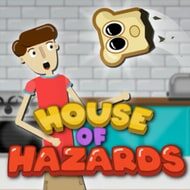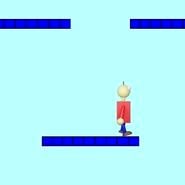

House Of Hazards is a fast-paced platforming game that throws players into a chaotic environment filled with traps and obstacles. The goal is straightforward: navigate through hazardous rooms and avoid deadly dangers to reach the end of each level. However, the variety of traps, unpredictable timing, and competitive multiplayer mode create an engaging challenge. Players must combine quick reflexes, timing, and strategic thinking to succeed in this game that balances frustration with fun.
Understanding the Gameplay and Controls
House Of Hazards centers around controlling a character that must jump, run, and dodge traps scattered throughout a multi-level house. The controls are minimalistic but demand precision, making the gameplay accessible yet challenging. Players quickly learn that every level is filled with different kinds of hazards, including:
- Spikes and Blades: Stationary or swinging blades and spikes are deadly on contact and require well-timed jumps to avoid.
- Moving Platforms: Platforms shift or disappear, forcing players to move carefully and anticipate changes.
- Falling Objects: From heavy chandeliers to random debris, unexpected falling hazards keep players on alert.
- Environmental Traps: Floors may collapse, walls might close in, or traps could activate randomly, making each run unpredictable.
Besides the individual hazards, players encounter the challenge of timing their moves perfectly. A jump too early or too late can mean instant failure. This need for precision is balanced by responsive controls that allow for quick recovery and retries.
Multiplayer Dynamics and Competitive Play
One of the defining features of House Of Hazards is its multiplayer mode. Here, players compete against friends or others in real-time as they race to complete the level first. This mode adds layers of unpredictability and excitement because players can:
- Race Through Traps: Speed is important, but so is avoiding hazards. Players must balance risk and caution.
- Interact with Opponents: Some versions allow pushing or knocking back other players, increasing competition.
- Use Level Design to Advantage: Watching where other players fail can help in timing your own moves.
This competitive environment means no two matches are alike, as player behavior heavily influences how the race unfolds. Multiplayer also encourages repeated plays to improve reaction times and learn trap patterns faster than others.
Tips, Tricks, and Level Progression
To make the most of House Of Hazards, players often develop strategies for advancing through levels that become more difficult as they progress. Key advice includes:
- Learn Trap Patterns: Many traps follow repeatable sequences. Memorizing these helps avoid sudden deaths.
- Practice Timing: Jumping and dodging with split-second accuracy is crucial for survival.
- Stay Calm: Panic leads to mistakes. Keeping composure helps in tricky sections.
- Use Shortcuts and Safe Zones: Some levels feature spots where players can rest briefly without danger.
As the levels increase in complexity, players face more traps simultaneously, faster-moving obstacles, and narrower safe zones. The game rewards those who can maintain focus and adapt quickly.
Customization and Replay Value
House Of Hazards often includes options to customize characters and settings, adding a personal touch to the experience. Some versions feature:
- Character Skins: Unlockable or selectable appearances to differentiate players.
- Custom Levels: Players can create and share their own trap-filled maps, increasing variety.
- Leaderboard Systems: Competitive players can track rankings and improve their best times.
The combination of challenging gameplay, multiplayer competition, and creative freedom makes House Of Hazards a compelling game that tests skills and keeps players engaged for extended periods.
Overall, House Of Hazards offers an intense platforming challenge where mastering timing, learning trap patterns, and competing with others creates a highly addictive experience.





















